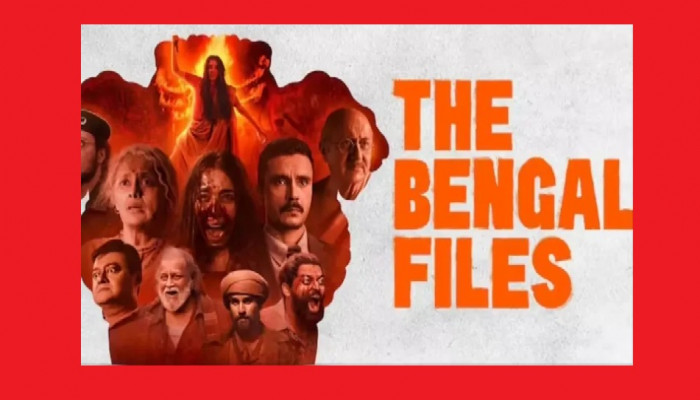The Bengal Files: A Blistering Portrayal of Reality
- In Movie Reviews
- 01:21 PM, Sep 17, 2025
- Rajabhishek Dey
Cinema has often been called the mirror of society, but sometimes the situation is such that it functions as the mirror society refuses to look into. The Bengal Files emerges precisely as one such mirror, dragging into daylight the dark corners of Bengal’s history that have long been silenced, softened or above all distorted. At a time when Bengal is once again grappling with political violence, identity crises and the erosion of civic trust, the film is not merely a retelling of the past. It is a provocation, a challenge and an act of remembrance.
To understand the urgency of the film, one must first glance at Bengal today. Stories from the present, of families struggling under a state of apathy, hostile streets, of corruption where “অনেকেই তো করে” (since many do it, why not me?), and of ordinary citizens silenced by political syndicates. At the same time, its higher intellectual legacies demonstrate to us that Bengal lives in a paradox. On one hand, it celebrates a rich cultural tradition of poetry, cinema, and intellectual pride; on the other, it easily hides the deepest scars of communal conflict, partition and systemic violence.
The fear is not abstract. Across social media and in public debate, voices from Bangladesh remind Indians of what happens when demographic imbalance, appeasement politics and state-backed violence converge: minorities disappear. A Bangladeshi narrator confesses, “আমি বাংলাদেশি। অন্যায়ের প্রতিবাদ করার সামর্থ্য নাই… সংখ্যায় কমতে কমতে এখন আর প্রতিবাদ করার লোকবল নাই।”(“I am Bangladeshi. I no longer have the strength to protest against injustice… our numbers have dwindled so much that now there are no people left to raise their voices.”) This chilling admission is not about history but about lived present: an acknowledgment that in West Bengal too, the same trajectory is feared.
The joke is on us
Imagine there… sitting down at a small tea stall, an old couple moving slowly through the crowded bazaar. The husband has faint vision due to a cataract operation ten years ago, and rests his hand on his wife’s shoulder. He was not born blind; illness claimed his sight later in life. The wife, practical as always, checks her bag- does she have change? If not, there may be an awkward argument with the tea seller while her husband looks away in shame, an old habit of avoiding confrontation.
They ordered two cups of tea without sugar and a couple of biscuits. The husband asks for “bakery biscuits,” though he cannot see what is on offer. A stray dog appears, tail wagging. The wife describes its colour to her husband and asks if he wants to share a biscuit. He tosses one, narrowly missing the dog’s face. Passersby chuckle “blind man”…mocking him without mercy. She steadies him as they rise, pays the bill, and they continue walking. Rain begins to fall. He worries about the umbrella. She, irritated but calm, says, “We’ll manage. Walk slowly.” And they walk on.
This tender but uneasy scene is the story of Bengal today. The couple are proud that their children live abroad…successful, settled, fluent in English. Yet their pride hides a deeper loss: their grandchildren no longer speak Bengali at home. They use the language only with grandparents over video calls, never with their parents. What was once identity has become ornament.
This “success story” masks a crisis. While some boast of children working in London or Toronto, Bengal’s young at home struggle with shrinking jobs, unemployment and underemployment. The paradox is cruel: those who leave forget, while those who stay are condemned to endure.
Language tells the story sharply. Grandparents are fluent. Parents are half-fluent. Children understand but rarely speak. Their children may be silent altogether. This “fishbone pattern” of cultural decline shows how heritage collapses, step by step. And when the urban educated elite stop speaking their own language, literature, theatre and music lose their audiences. Jatra pala gives way to streaming apps; local libraries shrink while global platforms expand. The slow death of a language is never loud…it is silent, like the grandchildren who will no longer know the songs their grandparents sang.
Politics deepens the fracture. A section of retired Bengalis treat Kolkata like a retirement home, erasing the memory of the Great Calcutta Killings and Partition violence, because it no longer matters to them… as their children are safe abroad. If suppose (I am not claiming) tomorrow Bengal becomes “West Bangladesh,” it makes little difference to them personally. But for the 39 percent who stayed…either by choice or compulsion- this erasure is deadly!
Meanwhile, elections are no longer about ideology but about machinery. The ruling party knows the art of booth management… using the police, local muscle, women’s groups, and the distribution of money to secure votes and occupy counting tables. Cars ferry loyalists to polling stations; central forces are courted. This is democracy in form, but not in spirit… an economy of patronage, where loyalty and cash matter more than dialogue or vision. Opposition leaders may deliver speeches and hold meetings, but without grassroots networks and financial muscle, they cannot compete.
And then there is the hypocrisy of the so-called liberal intelligentsia. A film trailer is enough to spark outrage. For years, they wore masks of free speech and artistic independence. But the moment their comfort is threatened, those masks fall. The Joker’s words from The Dark Knight apply here: morals and codes are “a bad joke,” discarded at the first sign of trouble. Introduce a little chaos, and the system collapses… because chaos treats everyone equally.
In the end, the image remains: the blind husband and the weary wife, walking into the rain to Apanjan Old Age Home, their old-age home, residential care sanctioned by the state government. Proud of their children abroad, yet mocked by strangers. Nostalgic for a culture their grandchildren will not inherit. Fearful of the storm, yet moving forward. That is Bengal today- proud, blind, enduring, and stumbling toward an uncertain future. The joke, as always, is on us!
Why the Film Stings
So, when I watched The Kashmir Files, I was shaken. But when I watched The Bengal Files, I was disturbed in an altogether different way. Because this was my race, my city. These were our people. The faces, the streets, the accents: this was not someone else’s tragedy. It was ours.
Some scenes were more brutal than The Kashmir Files. But the horror did not lie in their shock value… it lay in their familiarity. The narrow lanes, the political rallies, the slogans, the faces of leaders who still have echoes today. Yup…the film trailer launch was stopped in Bengal for a reason. It exposes too much. It reveals what many would prefer to forget. It shows us that history, if suppressed, will always return like an unhealed wound.
Performances That Carry History
The acting is not just a craft… it is a burden. Simratt Kaur, Namashi Chakraborty, Pallavi Joshi, Darshan Kumar.... all deliver powerhouse performances filled with anger, fear, and vulnerability. Anupam Kher, Mithun Chakraborty, Saswata Chatterjee, Sourav Das…each adds weight. Mithun, now a political figure, brings a layer of irony to his cameo. Pallavi Joshi embodies the conflicted conscience of a generation that both witnessed and denied.
Symbolism and Soundscape
Although making a slightly funny caricature of Gandhi and Jinnah (unlike earlier Bollywood films), Vivek Agnihotri does not drown the film in entertainment melodrama. He uses Bengal’s own culture as his scalpel. Baul music slips in unexpectedly, with the ektara appearing in people’s hands. Portraits of Renaissance men…Vivekananda, Tagore, Aurobindo… stare down from walls and offices, as if silently watching Bengal betray itself. And here, the Durga idol in the Noakhali office reminds us of Bengal’s ancient Hindu identity (not any modern-day Durga or Kaali idol that is mainly worshipped), reminding Bengalis of thousands of years of the past!
Two songs pierce through the narrative like memory itself: Kichudin Mone Mone and Dwijendralal Ray’s Dhono Dhannye Pushpe Bhora, sung in Hemanta Kumar’s immortal voice. These are not nostalgic flourishes… they are reminders that Bengal’s golden culture was burning alongside its people.
Mother India, as Maa Bharti herself becomes a character, speaking of double-faced demons and forked tongues. She reminds us: what Bengal thinks today, India thinks tomorrow. This is no mere slogan. The film shows it through parallels: the body of the Sheikh played by young Ekalavya Sood torn apart during Punjab’s Partition and Nehru’s speech starts “Tryst with Destiny”, the antagonist recalling of Kashmir’s “Ralib Galib Chalib” reminds us how the problems with Hindus are universal and recurring and follow the same pattern throughout history.
Even the choice of the child’s name “Taimur” carries layered satire…mocking which Bollywood celebrity family don’t know: while reminding us of India’s violent past and anti-Indians’ future motifs.
Reality Masquerading as Fiction
There is no fiction here. None. Yes, I insist: what you see happened. And that is the best part of the film I liked. It seems that the director has been very well prepared with all the answers to all the probable questions and references to be asked in future!
For example, the character of Golam Sarwar represents the hypocrisy that thrives today: men who preach madrasa education for others while sending their own children abroad. The Razakars of Bangladesh followed the same script… men who collaborated with Pakistan, then later became opposition leaders, educated their children in the West, and lectured others on visiting Madrasa! The character of Shashwata Chaterjee, his family’s cultural status modelled this, along with somehow also on “respected” social workers like Sheikh Shahjahan (may be)- shows how easily the mantle of philanthropy can hide a violent legacy. The police, meanwhile, are portrayed as perfect clowns, incompetent and corrupt, as it is today.
Again, take another crucial example where Priyanshu Chatterjee plays the judge…helpless, ideological, a man in between the city’s burns who believes in the secular dream. Yes… he is also real. I will not give any references here to make the discussion more prolonged. If you have time and interest…please read about those Hindu teachers and intellectuals who clung to nationalism and secularism only to be betrayed by their students, astonishingly, one fine morning, who became rioters, killers, and opportunists. His character is not invented. These people existed and are still there.
Many records, biographies and autobiographies testify to their existence… their naivety, their disillusionment (unfortunately, not any film). In reality, we also find how these ideologies of nationalism and secularism were further carried forward- the first translation of the Quran into Bengali was done by a Hindu. Hindus and Hindu values highly contributed to the language movement in East Pakistan later.
Yet when persecution came, they fled or were killed. Unfortunately! Those who reached India often turned communist, conveniently erasing their past, teaching their children nothing of what they endured, just lamenting “Amago ekkhan desh achilo!” (Once we had a land!)
The Names That Haunt Us
Seventy-three years ago, Bengal was torn apart by men whose names still echo if you have ears. Huseyn Shaheed Suhrawardy, then the Premier of Bengal and his subordinate Sheikh Mujibur Rahman, later hailed as the “greatest Bengali of a thousand years.” Out of context…once, the Muslim Mayor of Calcutta, Muslim Mayor of Calcutta, Osman Khan, distributed a pamphlet in Urdu. It read: ‘Do not lose hope, raise your sword, O kafirs, the day of your destruction is not far away.’ The leaflet also contained a picture of Jinnah holding a sword.
Now replace the name of the Mayor with Firhad Hakim. 2+2=4! Right? The message is blunt: yesterday’s leaders who enabled bloodshed are mirrored in today’s leaders who enable silence.
The Pattern of Erasure
This erasure is why my textbooks were empty. This erasure is why I did not know Gopal Mukherjee. This erasure is why generations can grow up in Bengal and know nothing of Bengal’s own holocaust.
The Bengal Files achieves both scale and intimacy. It does not allow us the comfort of distance. Every scene is designed to wound the conscience. It is an eye-opener, not because it tells us something we never knew, but because it forces us to acknowledge what we were never allowed to remember.
The film is like a cigarette packet that reads, “Smoking kills.” We may laugh, ignore, or dismiss. But cancer does not go away. History is the same. We can ban a film. We can suppress chapters. We can ridicule survivors. But the past remains, festering.
Erased Histories as recovered: Gopal Paṭha, Bengal’s Women and the Silence of the Elite
One of the strengths of The Bengal Files as a movie is that it does not reduce history to faceless statistics. Numbers alone cannot carry the weight of human suffering; it is through characters, both real and reconstructed, that the film breathes life into memory. The film resurrects forgotten voices… heroes erased, women silenced, and communities branded as either villains or martyrs depending on political convenience.
Among the figures brought back into public consciousness, none is more striking than the sacrifices and actions of Rajendra Lal Roychowdhary and Gopal Chandra Mukhopadhyay, affectionately known as Gopal Paṭha. Though the state branded the latter one a “goonda.”
Later leftist intellectuals dismissed him as a communal thug. But to those who survived because of him, he was nothing less than a guardian. As the document records, people called him Calcutta’s “অঘোষিত রক্ষক”…the city’s unofficial protector. The Bengal Files makes a political choice by restoring his dignity. In doing so, it contests the long-standing suppression of Hindu resistance figures who do not fit into neat secularist narratives.
Perhaps the most harrowing sequences of the film involve the women of 1946. The film confronts audiences with these images, not to sensationalise but to memorialise. As one of the fighter’s documented videos states, “In Kolkata’s Rajabazar area, Hindu women were raped, their dead bodies bound hand and foot, stripped completely naked, their breasts cut off, and then hung from the meat shop hooks by the roadside.” Its true.
Moreover, in Noakhali, apart from burning Hindu men alive, hanging, entire villages of women were forced into conversion, their sindoor was erased with toes, and many were married off to their rapists. Countless others chose suicide over dishonour, echoing the tragic choices made during medieval invasions.
Yes, in a society where even today women’s suffering and sexual violence are often erased, these depictions are radical. They demand acknowledgement that sexual violence was not incidental but central to the genocide…a weapon of war designed to humiliate and terrorise an entire community.







Comments